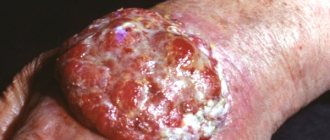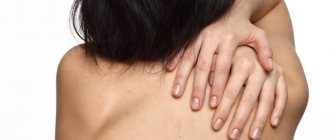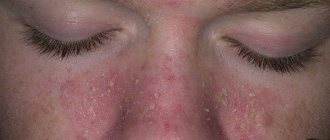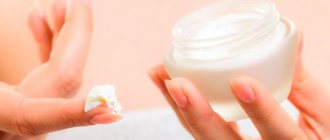What is harlequin syndrome and how is it treated? harlequin syndrome in newborns
Harlequin ichthyosis is an inherited disorder that occurs at the genetic level.
All possible causes of Harlequin ichthyosis have not yet been fully investigated. In the fetus at 4-5 months of intrauterine development, a shortening of the polypeptide chain in the ABCA11 gene occurs.
https://www.youtube.com/watch?v=p50cexyJ_fg
As a result of this process, the protein responsible for the normal development of the skin disappears from the gene.
The mutation leads to the fact that the baby is born with a “shell” of dehydrated and dense skin. Doctors also note significant distortions in the shape of the nose, ears, mouth and eyelids. The limbs of a newborn are often deformed; in addition, neonatologists diagnose abnormal development of important internal organs.
The disease is transmitted to children only in one case - if each of the biological parents is a carrier of the altered gene. If one of the parents is the carrier of this gene, then the unborn child is not in danger. But in such a situation, the baby also becomes a carrier of the mutated gene.
The disease is very rare; statistics indicate one case per 800,000 healthy children born. Ichthyosis affects both sexes equally. It is impossible to examine pathology in the early stages using ultrasound.
If the diagnosis is confirmed, the only chance to avoid the birth of a seriously ill baby, for whom life will be short and very painful, is to decide to terminate the pregnancy.
Forecasts and course
Harlequin ichthyosis is completely untreatable. Only comprehensive and continuous supportive therapy can prolong a child’s life. But even despite it, children with this diagnosis often die in the first weeks of life due to secondary complications such as sepsis, respiratory failure, infections, etc.
British research shows that early use of oral retinoids improves survival, but even so, children who survive have many serious complications. There are several known patients with harlequin ichthyosis whose age exceeded 20 years.
The development of medicine does not stand still; the latest achievements of plastic surgery are coming to the aid of children with congenital Harlequin ichthyosis. In 2020, a publication appeared by specialists from the Department of Plastic and Reconstructive Surgery in New York, who managed to perform surgery on a newborn baby with this diagnosis on the first day of life, which allowed not only to save the child’s life, but also to avoid serious complications.
Photos used from Shutterstock
Used sources
Cardiac Abnormalities in Harlequin Ichthyosis: First Case Study / Verma B., Mohan A., Singh A. etc. // Journal of Cardiovascular Disease Research. — 2020. — No. 9 (3)
Harlequin ichthyosis: a review of clinical and molecular findings in 45 cases. / Rajpopat S., Moss C., Mellerio J. etc. //Arch Dermatol. — 2020. — No. 47 (6)
Congenital ichthyosis: an interesting clinical case / Dukhonina O.M., Chernenkov Yu.V., Panina O.S. et al. // Saratov Medical Scientific Journal. — 2020. — T. 9 No. 2
Congenital ichthyosis / Orlovskaya I.V., Ryumina I.I., Perepelkina A.E. // Russian Bulletin of Perinatology and Pediatrics. - 2009. - No. 6
Surgical Management of Harlequin Ichthyosis / Margulies IG, Harburg L., Zellner E. // Plast Reconstr Surg Glob Open. — 2020. — No. 7 (5)
Harlequin syndrome has an extremely unfavorable course and an unsatisfactory prognosis. The majority of newborns die after birth due to prematurity, sepsis, or disturbances in electrolyte balance and thermoregulation.
Mother bathes baby in bleach to save harlequin ichthyosis (photo)
Attention! Photos in the text may shock you
A Washington state woman bathes her one-year-old son in bleach weekly to ensure the boy survives. This is how she helps a child fight an incredibly rare genetic skin disease - harlequin ichthyosis.
Alicia Barber gave birth to Jamison in March 2020, and her son was diagnosed with a congenital condition that affects only one in 500,000 people.
With harlequin ichthyosis, a child is born covered with hard and thick (up to 1 cm) diamond-shaped scales, separated by deep cracks.
Due to skin abnormalities, children have everted eyelids, damaged ears, and often missing nails.
The body of a child born with harlequin ichthyosis cannot regulate the water balance in the tissues and fight pathogens.
That is why only a few survive with such a diagnosis, but Alicia Barber does not intend to give up. The woman (who already has a 7-year-old son and a 6-year-old daughter from her husband's first marriage) is now with Jamison around the clock.
Due to the fact that the boy's body is vulnerable to any infection, his bedding, toys and everything else he touches must be disinfected daily.
Clinical picture of the disease
The disease is characterized by impaired keratinization. Dense scales appear on the skin.
They are welded to the epidermis and are difficult to scrape off. Plus, additional deformities are often identified.
Harlequin ichthyosis is a chronic disease with a monotonous course.
Children with this syndrome are often stillborn or die in the first months of life. They are very premature and very weak. The chance of a sick child surviving to adulthood is less than 1%.
The main characteristics of the Harlequin fruit:
- the skin is dry, dense, thick, covered with a shell that resembles a shell. It consists of diamond-shaped horny scutes. The color of the scales is gray, thickness is up to 1 cm. Between them there are deep bleeding furrows and cracks;
- the plates are very dense, they tighten the skin, causing deformations of the face and torso. Sometimes they make it difficult to breathe, squeezing the newborn’s chest;
- the baby’s mouth does not close, causing a “smile” (due to the similarity with Harlequin’s makeup, the name of the disease appeared). In rare cases, the baby's lips are closed so much that it is difficult to even insert a feeding tube;
- all the cracks on the face are irregular in shape;
- ears are underdeveloped;
- eyelids turned inside out;
- the nose is flattened;
- hair and nails are often missing;
- the arms and legs are swollen and partially bent; it is very difficult to straighten them independently due to the dense keratinized scutes.
Photos of babies with Harlequin ichthyosis
The baby may also have other genetic defects: cleft lip, cleft palate, microcephaly, the presence of a sixth finger, skeletal defects, etc.
As the child grows, deafness and vision loss may be detected. Also, children with ichthyosis often have problems in the development of the nervous system and severe immunodeficiencies.
The severity of the condition with ichthyosis is caused by:
- poisoning of the infant body with skin breakdown products;
- extensive affected area;
- a large number of cracks and erosions that easily become infected; in severe cases, sepsis is possible;
- dehydration and development of hypernatremia (increased amount of Na ions in the blood);
- mild hypothermia;
- a large number of concomitant diseases;
- the difficulty of fully diagnosing the patient.
Such children are aware of their inferiority from infancy. They are disabled, and, basically, cannot do without outside help and care.
Survivors of harlequin ichthyosis
In the popular Soviet film “Amphibian Man,” the main character Ichthyander is a handsome, attractive young man from whom you can’t take your eyes off.
But a fairy tale is only a fairy tale, so as not to be a reality.
In real life, there are also “ichthyanders” - this is the name given to people suffering from the rare hereditary disease harlequin ichthyosis. Unlike the character of Vladimir Korenev, you cannot look at these sufferers without tears.
All 20-year-old girls dream of love - this is an indisputable fact. But Hunter Steinitz from Pittsburgh, Pennsylvania, USA, passionately wants only one thing - to get well.
https://www.youtube.com/watch?v=8Q2CbCCjv9E
Unfortunately, the girl’s dreams are never destined to come true. From the first days, the American woman has been suffering from a terrible and incurable disease called Harlequin-type ichthyosis.
This is a congenital disease. When a child is born, his skin is covered with gray-beige scales, the thickness of which reaches 1 cm. Deep cracks can be seen between them. The hard scales are tightly stuck together, causing the baby's mouth to be either stretched or narrowed so that the feeding tube can hardly pass through the lips.
Due to skin abnormalities, the eyelids are turned out, the ears are damaged, nails are often missing, there are bridges between the fingers and toes, and skeletal defects are also observed. Due to the high tissue density, the hair follicles are blocked, so there is not a single hair on the body.
The body of a child born with this diagnosis is unable to regulate the water balance in the tissues and cannot fight pathogenic microbes. In this regard, most children die immediately after birth from lack of water in the body or from microbes. For this reason, doctors consider the disease incompatible with life.
If a baby with Harlequin ichthyosis does not die in the first months after birth, his condition remains very serious, and the probability of surviving to 12-13 years is 2-3 percent. Only one out of several hundred patients survives to the age of 18. Hunter Steinitz is a rare specimen, she has been alive for 21 years!
Babies with Harlequin ichthyosis often die soon after birth and look like something out of a horror movie.
LIKE A FISH IN WATER
Every day is a struggle for survival for Hunter. The morning begins the same way - with a bath. The girl sits in warm water for a long time—two hours. This is a necessary measure, because the skin is sorely lacking in water. To ensure that the skin absorbs as much moisture as possible, the poor thing rubs it with various lotions, oils and balms.
Rubbing has to be repeated several times a day, otherwise the body risks dehydration. Hunter is a regular at the local pool. Other swimmers are accustomed to the strange visitor with skin defects, but such a sight is a wonder for beginners. However, they react to her this way not only in the pool - everywhere.
At first, many try to avoid the girl, and some have hysterics if she accidentally touches them. Most people unknowingly believe that the disease is contagious. Previously, Hunter was very worried when she saw that people were avoiding her on the tenth road, but now she began to approach strangers herself and explain that she would not cause them any harm.
Harlequin ichthyosis is not transmitted from person to person. “One of the most difficult problems in the life of patients with harlequin ichthyosis is the reaction of others. When they first meet, most people experience a powerful shock: they don’t know what to say or what to do,” says the persistent girl.
WILL LIVE!
People can also be understood. Hunter Steinitz, as painful as it is to admit, looks like she's from a horror movie. It seems that the girl was seriously injured in the fire and all her skin was burned. The skin color is not the same as everyone else's - pale pink, but bright red, like beetroot. The whole body is covered with crust.
The skin constantly cracks, making it seem as if the girl is covered with scales, like a fish. The fingers and toes bend poorly, the skin is so thick. His eyelids are turned inside out and Hunter can't close his eyes. Moreover, the poor thing can't even blink.
When a girl sleeps, her eyes still remain open. There are no eyebrows, as well as hair on the head. That's why Hunter wears a wig all his life. No matter how hot it is, she never sweats.
However, a serious illness strengthened the girl’s spirit: several years ago she successfully graduated from college and enjoys communicating on Facebook. To the best of her ability, the young American woman leads an active lifestyle. In recent years, she regularly gives lectures to schoolchildren and students, telling them about her illness and the difficulties that fill her life and the lives of her fellow sufferers.
This girl's name is Brenna, she is 4 years old. Her mother uses organic coconut oil to soften her baby's skin.
This girl's name is Mui Thomas, she is 22 years old and she is also one of the rare lucky ones who lived to this age
Stephanie Turner, 23, lives in Arkansas. She is the mother of two children, who fortunately did not inherit her disease
TO NOT GIVE UP
Englishwoman Nellie Shaheen (real name Nasreen), born in 1987, also did not die in infancy. Now Nellie is 30 years old and she is the absolute record holder for those with this disease. Despite her serious illness, Nellie leads an active lifestyle. He is interested in sports and goes shopping with great pleasure.
Of course, the disease seriously complicates her life. Look at the sidelong glances of others, and any little thing like a splinter from a street bench can cause an infectious disease in a girl and send her to bed for several weeks.
But the Englishwoman does not give up. And this despite the fact that the insidious disease claimed the lives of her four brothers and sisters (there were nine children in the family). Shaheen overcame the usual isolation for such patients and, as they say, went out into the public eye.
Not only has she received an education, but she also constantly participates in television shows and actively speaks on behalf of fellow sufferers. Harlequin ichthyosis now affects 14 people in the UK. Nellie actively communicates with other patients using Facebook, exchanging subtleties and techniques that help make life easier.
RARE DISEASE
Ichthyosis was first described in 1750 by a priest from South Carolina, USA, Reverend Oliver Hart,
“On Thursday, April 5, I went to look at a unique specimen - a child born at night to a certain Mary Evans. Everyone who saw the baby was dismayed, and I still don’t know how to describe what I saw. Its skin is dry and hard and resembles fish scales. The mouth is large and open.
The child was born with two holes instead of a nose. The eyes are huge, bloodshot and bulging like a plum. Ears are also absent, in their place there are only small holes. The arms and legs are swollen and hard as stone. The baby lived for about two days and died.”
To date, scientists know about 30 varieties of ichthyosis - a severe congenital pathology, the causes of which have not yet been established.
Harlequin ichthyosis in children
One sick child is born in a ratio of 1x1000000. Children have cracks, formations in the form of scales on the skin that fit tightly to each other.
The formations tighten the mouth and fingers, and movements are limited. Feedings are only possible through a tube. Because of their clumsy, inverted eyelids, they sleep with their eyes open.
Because the plates tighten the abdomen and chest tightly, it may be difficult for the child to breathe.
The skin is pink and reddish in color. It is very dry and requires a constant flow of water. Due to lesions throughout the body, on which there are formations in the form of thick plates, an imbalance in water balance occurs. Most children do not live to see 10-12 years of age. They require careful care, constant care and attention.
Children with this disease are transferred to intensive care wards immediately after birth. The thick, lamellar skin soon begins to peel off. It peels off centimeter by centimeter. The process takes several weeks.
Children are given antibiotics to prevent infections. When the thick skin completely peels off, the baby is left with red, dry skin. Thin plates may remain on it. After bathing, the dermis is lubricated with ointments and emollient creams. During the first weeks of life, suffering babies require constant care. You can't leave them for a minute.
Description
Harlequin ichthyosis is the most severe form of inherited ichthyosis.
The word ichthyosis, which comes from the Greek word for fish, is a descriptive term used for a group of inherited disorders in which the skin is noticeably thickened, bulging, and cracked. Thus, the term "harlequin ischemia" is used interchangeably with "harlequin fetus". Other synonyms over time have included:
- emphytic ichthyosis,
- ichthyosis intrauterine,
- diffuse keratosis,
- congenital diffuse malaria keratoma,
- malignant keratosis.
Ichthyoses as a group are caused by a number of basic metabolic disorders. However, the net effect of each abnormality is the same: keratinization, or differentiation of the cells that make up the skin, does not occur normally. Ichthyoses are classified based on their clinical features and the age at which symptoms appear.
Ichthyosis of the newborn refers to those disorders that appear either at birth or shortly thereafter. Each new-onset ichthyosis may be due to a different genetic abnormality, even if there is some similarity between the clinical features. However, harlequin ichthyosis is such a distinct and striking disorder that it is rarely confused with other types of ichthyosis.
The word "harlequin" is often used to describe a mottled pattern or combination of spots on a solid background of contrasting color. Abnormalities of internal organs are uncommon but have been reported in some people. Death often occurs early due to severe skin infection.
Ichthyosis on the hands of children
Ichthyosis on the body of a child
Ichthyosis on the skin of a child
Ichthyosis on the face of a child
Ichthyosis of the skin on the legs of a child
Ichthyosis of the skin on the body of a child
Scientists' opinions on this matter are divided. Most of them believe that the main cause of the pathology is a gene mutation. Other researchers think that the reason lies in malfunctions of the thyroid gland and hormonal disorders.
Children most often suffer due to heredity. The current mutation prevents the formation of a normal stratum corneum, which is covered with scales, cracks, and formations. Fat and protein metabolism are disrupted, cholesterol increases, and the number of amino acids increases.
The disease can be inherited as an autosomal dominant trait. The initially dry, whitish dermis is covered with whitish, gray-black scales. With other types of illness, the baby’s body becomes bright red.
With a mild degree of the disease, the so-called abortive course, the symptoms are mild. This is only a slight peeling and dryness on the extensor limbs. But even here it is necessary to intensively care for the affected areas.
At birth, all babies are covered, as it were, with plates, a kind of shell. After a short time, peeling begins, the top, thick layer comes off. After exfoliation, doctors determine the exact diagnosis. Particularly severe cases appear immediately.
Is skin ichthyosis dangerous for children? Severe illness can be fatal. With this diagnosis, 2-3% of babies survive, but only thanks to careful care. After birth, they are immediately sent to intensive care wards. Those born prematurely are placed in special feeding chambers.
Even during pregnancy, the expectant mother can find out about the disease of the fetus through a biopsy. The doctor takes a scraping and makes a diagnosis. The decision always remains with the parents.
Skin ichthyosis in children
A similar hereditary disease can appear during the development of the fetus in the womb around the fourth or fifth month.
In this case, children are born with an altered skin structure - the presence of peels and scales of various sizes. The disease can affect the mouth, ears, eyelids, which can affect vision and eating.
With such a diagnosis, webbing on the fingers and skeletal deformation are possible.
Most often, the disease manifests itself most actively before the age of three.
Areas of peeling skin over time turn into keratinized skin with so-called fish scales of a gray or dark shade; redness of the skin with the presence of a film may be observed.
The lines on the palms become pronounced. The disease may be accompanied by itching, burning, and painful sensations when the scales separate.
In addition to the external manifestation of the disease, the following changes are possible:
- Deterioration of the structure of hair and nails - their separation and fragility.
- Conjunctivitis of the eyes.
- Development of myopia.
- Allergic reactions.
- Kidney diseases.
- Dental caries and destruction of tooth enamel.
- Heart failure.
In such cases, treatment should be started immediately according to the doctor’s recommendations and under his supervision.
Early therapy is provided for newborns - the child needs to maintain optimal temperature and air humidity, for which he is placed in an incubator.
A comprehensive examination of the patient by a surgeon, ophthalmologist and other specialized specialists is carried out. Further additional treatment is prescribed. It will be chosen depending on the exact diagnosis - the type of ichthyosis and the severity of the disease.
Which doctor should I contact?
Children diagnosed with harlequin ichthyosis have low birth weight and a number of other complications caused by this disease. Previously, such babies quickly died due to infection as a result of disturbances in thermoregulation. But modern medicine has achieved some successes in the study of this pathology, which make it possible to save the life of a newborn. With such diseases, you should seek help from doctors of the following specialties:
An infectious disease specialist can also help. But before prescribing therapy for the baby, the specialist must talk with the parents of the newborn. During the survey, he will ask them approximately the following questions:
- How was the pregnancy (was there any threat of failure)?
- Have you used any drugs?
- Do you have a history of genetic diseases?
- Do you abuse alcohol?
- Do you come into contact with hazardous products?
Since the signs that accompany harlequin ichthyosis may indicate other pathologies, the doctor may order a skin biopsy of the baby. Only after all the tests will the specialist be able to create a course of therapy aimed at reducing the symptoms of the disease and improving the quality of life.
Prevention
To prevent the activation of pathological processes on the skin, you should be attentive to the appearance of changes in its condition, and also undergo a timely examination by a dermatologist.
As a preventative measure, it may be recommended to attend consultations for those couples who have a history of lamellar ichthyosis and are planning pregnancy. This will allow me to be accepted to reduce the risk.
Regular hygiene procedures using products high in vitamin A will help maintain normal skin condition and elasticity. This is especially important at the initial stage of the disease.
Prevention of ichthyosis includes consultation with a geneticist at the earliest stages of fetal development. It is impossible to prevent the development of the disease in any other way. The prognosis is generally unfavorable - patients are mostly susceptible to complications.
Ichthyosis is a complex pathology, but it is treatable. In therapy, patients can use not only medications, but also a change of place of residence.
Despite the high risk of death with ichthyosis in children, cases where the child developed and lived a normal life are not uncommon. Therefore, when making this diagnosis, it is worth contacting specialists for treatment.
The video contains a detailed description of a disease such as ichthyosis and the history of a person with congenital pathology. Socialization and difficulties of everyday life of patients with ichthyosis.
Post Views: 1,501
Treatment of congenital ichthyosis
Therapy for Harlequin ichthyosis has been unpromising for a long time. Almost all children died in the first year of life. In 1965, in St. Petersburg they began to develop a method for managing patients with congenital ichthyosis.
Currently, patient therapy is based on three principles:
- sterility – the conditions in which the child is kept must be absolutely sterile. As a rule, these are special boxes in intensive care;
- hydration – water loss through the skin should not be allowed;
- heat supply - in any baby, the thermoregulation system is defective up to 6 months, and this applies to a greater extent to children with ichthyosis.
After a diagnosis of Harlequin ichthyosis has been made in the maternity hospital, the patient is placed in an aluminum foil blanket and taken to the intensive care unit. The container in which it is contained must have 70-80% humidity and a temperature of at least 35-36oC. All surfaces that the baby’s skin comes into contact with are thoroughly disinfected. Medical staff always use sterile gloves.
The umbilical vein is used to administer medications and a catheter is placed in it.
Treatment of ichthyosis
The outcome of the disease in most cases depends on the severity of the disease and the degree of gene mutation. With a mild mutation and timely therapy, successful treatment, or at least an improvement in the patient’s quality of life, is possible. A less favorable result is predicted in case of metabolic disorders and damage to other body systems, in addition to its genetic changes.
As a rule, treatment consists of moisturizing the skin - this is required to reduce the dryness of the skin and reduce its cracking.
Medicinal ointments, creams, moisturizers based on lanolin or petroleum jelly are prescribed, and additional keratolytic therapy is carried out.
In some cases, baths with special solutions may be prescribed - soda, starch, salt, sometimes with the addition of chamomile or sage.
Vitamin complexes are sometimes prescribed as medications - vitamins A, E, C, B are important for the skin, and, if necessary, antibiotics, medications to maintain thyroid function, antifungal agents, and iron supplements.
Additional recommendations may include the following:
- Prolonged exposure to the sun and overheating of the skin are not recommended;
- Using soap can cause additional dry skin;
- It is worth limiting the time spent in the cold - dry cold air can aggravate diseases;
- Sanatorium treatment in places with a warm, mild climate will be favorable; in some cases, swimming in the sea is allowed.
In any case, you should not self-medicate, especially with such a serious diagnosis. Consulting a doctor and strictly following his recommendations can significantly improve the patient’s quality of life and prevent the development of irreversible consequences.
If you have any skin problems, you should consult a doctor; widespread peeling is no exception. It may hide an unpleasant diagnosis - ichthyosis. Due to its hereditary origin, treatment can be quite lengthy, complex, and requires a lot of patience. It is important not to give up, because modern medicine offers many ways to make the patient’s life easier and better.
Complications
In the absence of treatment or the wrong choice of treatment method, the manifestations of the disease are likely to worsen, which significantly worsens the overall quality of life of the patient.
Swelling of the skin may appear, weakening of its functions, and in infancy, with the active development of complications, death is likely.
Complications of lamellar ichthyosis include the transition of the initial form to a more advanced form, when the symptoms are already expressed as strongly as possible and cause discomfort to the patient. The increase in infant mortality if they have this disease is insignificant.
Treatment of skin ichthyosis
It is impossible to completely cure skin ichthyosis, but it is possible to reduce the course of the disease and reduce the frequency of relapses. Patients with skin ichthyosis of any classification require complex treatment, proper and regular skin care. Therapeutic treatment of skin ichthyosis consists of taking the following medications:
- Vitamin therapy - vitamins A, E, PP, C, group B, taken in courses of 2 - 3 months.
- Corticosteroid hormones - prescribed if necessary.
- Lipotropic drugs - reduce keratinized skin scales.
- Immunotherapy.
- Blood plasma transfusion.
- Calcium, iron, gamma globulin preparations.
In severe forms of skin ichthyosis or in congenital forms of the disease, the doctor prescribes hormonal therapy. If such treatment gives a positive result, then their use should be stopped slowly. All medications are prescribed to patients in accordance with the patient’s age, body weight, form of the disease and other characteristics.
Treatment should be carried out under the supervision of a doctor, since many of the drugs can have a toxic effect on the body, especially in cases where ichthyosis is treated in children.
If you have ichthyosis, you need to monitor the condition of the skin itself. For treatment, you can use ointments, nourishing creams on a natural basis; it is also recommended to take baths in a solution of potassium permanganate or add various salts, herbs, and calcium chloride. You can add various substances to the bath only after prior consultation with your doctor.
A good effect can be obtained from physiotherapeutic procedures: carbon dioxide baths, ultraviolet irradiation, heliotherapy, and mud therapy. Such procedures stimulate metabolic processes in tissues and improve skin condition.
Skin with ichthyosis needs constant hydration, so you need to use a cream that contains vitamin A. Ichthyosis of the skin is a disease that cannot be gotten rid of, but regular skin care, proper and timely treatment can reduce the number of exacerbations, thereby prolonging remission .
Diagnostics
- electron microscopy of fetal skin particles (sampling of material for research is carried out under ultrasound or fetoscope control);
- diagnosis based on chorionic villi (this study is carried out at a period of 7-16 weeks under ultrasound control);
- amniocentesis (analysis of amniotic fluid);
- 3D or 4D ultrasound examination.
If Harlequin ichthyosis is confirmed in the fetus, the woman is clearly indicated for artificial termination of pregnancy. To date, doctors cannot offer any alternative for parents of children with this disease.
The diagnosis of “Harlequin syndrome” is made in accordance with the characteristic clinical manifestations and data from neurological studies, which includes MRI of the spinal cord and brain.
Differential diagnosis of this syndrome should be carried out with a milder form of congenital ichthyosis, the so-called “colloidal fetus”.
Histopathology. In the skin biopsy of patients with Harlequin syndrome, there are signs characteristic of this pathology: compact orthokeratosis and thickening of the stratum corneum and absence of the granular layer, obstruction (obstruction) of the ducts of the exocrine (sweat) glands and the presence of hyperkeratotic detritus in the sebaceous glands.
Ultramicroscopy. When examining the granular layer, pathologically transformed lamellar bodies are observed in it, and in the stratum corneum there is a complete absence (lack) of lipid platelets and/or lipid inclusions.
Treatment of harlequin ichthyosis
The child requires an interdisciplinary approach, including consultations with many specialists - an ophthalmologist, a surgeon, a gastroenterologist, a nutritionist, and a psychologist. In order to ensure proper nutrition, he may have a gastrostomy tube installed.
Therapy includes:
- hydration of the child’s body;
- administration of opioid analgesics, for example, morphine, fentanyl, sufentanil (to reduce the pain response to tissue damage);
- administration of etretinate, a retinoid for the treatment of psoriasis and other scaly diseases;
- use of emollients for the skin and mucous membranes; prescribing antibiotics to prevent infection; psychological assistance.
Thick, cracked plates will gradually peel off and fall off. After a few months, thin, dry skin of a bright pink color (in places covered with small scales) will appear in their place.
This means that the baby has reached a critical stage in his life and intensive care can be completed. However, for patients diagnosed with harlequin ichthyosis, treatment will last a lifetime.
It consists of constant body care - using keratolics to remove scales and emollient creams to reduce dryness.
Appearance mechanism
Ichthyosis disease belongs to the category of genodermatoses with a poorly understood mechanism of occurrence. The reason for its development is a gene mutation inherited from parents to children. Ichthyosis is a congenital disease, so it is impossible to completely eliminate its manifestations.
Failures in metabolic metabolism, when aminocarboxylic acids accumulate in the blood and the absorption of lipids slows down, are the result of a gene defect.
Disruption of protein metabolism and an increase in the concentration of cholesterol in the blood serum is one of the key causes of genodermatosis. When biochemical reactions slow down and oxidative reactions increase, thermoregulation is disrupted.
Most patients suffering from genodermatoses are diagnosed with dysfunction of the adrenal glands, thymus gland and gonads (ovaries and testes).
Congenital ichthyosis is transmitted genetically and is not contagious. Due to impaired absorption of retinol, malfunctions of the sweat and sebaceous glands occur.
Therefore, the processes of keratinization of the epidermis do not proceed correctly: the thickening of its stratum corneum is excessive (hyperkeratosis). Excessive keratin synthesis leads to changes in skin structure and slower shedding of dead cells.
Keratinocytes increase the density of the skin, causing a characteristic pattern resembling fish scales to appear on the body.
The function of the epidermis is to protect the deep layers of the dermis from pathogenic fungi, protozoa, bacteria and viruses. But if it is affected by ichthyosis, resistance to pathogens decreases, which creates conditions for infectious tissue inflammation. In adults, the disease is sometimes complicated by pathologies of the liver, heart and other internal organs.
Features of the diagnosis of ichthyosis and its symptoms
Ichthyosis is a skin disease of genetic origin. It is characterized by a disruption of the process of keratinization of the skin - in the epithelial tissue there is a failure in the production of horny substance, which contains keratohyalin, keratin and fatty acids.
With the development of the pathological process – hyperkeratosis, peeling of the skin begins. Depending on the severity and stage of the disease, light flaking may be observed, or a layer resembling fish scales may form.
Such formations can be gray, brown, dark or flesh-colored.
As a rule, this is an independent disease. But as an additional symptom, ichthyosis can be observed with the following diagnoses:
- Leiner's erythroderma;
- Ritter's dermatitis;
- one of the varieties of pityriasis pilaris red is erythrodermic;
- the following syndromes are Rud, Jung-Vogel, Refsum, Sjögren-Larsson and some others.
Often, to clarify the diagnosis, an external symptom is enough - the appearance of similar roughness on the skin. As a rule, they do not appear on the elbows and knees, or in the groin area.
Sometimes the disease is accompanied by itching and pain on the skin.
Additional symptoms may include decreased sweating, separation or reduction of nails, cracks in them, increased cholesterol, and impaired protein or fat metabolism in the body.
The peculiarity of the disease is that it worsens in the winter, when exposed to dry frosty air, while in warm countries with a humid climate or in the summer, some improvement may be observed.
But this factor should not negate compliance with medical recommendations to combat such a disease.
Often, if the clinical picture and anamnesis are insufficient, a histological examination, blood test, and comprehensive examination by specialized doctors are performed.
Common forms of ichthyosis disease
There are several types of ichthyosis, the manifestation of which depends on hereditary factors. Here are some of them:
- harlequin ichthyosis;
- lamellar;
- vulgar;
- epidermolytic;
- x-linked.
Harlequin ichthyosis
Sometimes this diagnosis is also called fetal ichthyosis. Children with this diagnosis are usually born premature and with low weight. Externally, the diagnosis is manifested not only by peeling of the skin, but also by changes and redness of the eyelids, ears, mouth, and limited movements of the joints of the arms and legs. The skin of a newborn is covered with gray or brown scales with thickenings and cracks.
A similar disease appears as a result of a mutation in the ABCA11 gene - its polypeptide chain is shortened, resulting in irreversible changes during fetal formation. As a result of this process, the functionality of lipids is impaired - they are not capable of forming the stratum corneum of the skin. Ichthyosis is most often visible after birth, but, as a rule, during an ultrasound it is possible to track some signs of the development of abnormalities, especially if the parents have a hereditary predisposition. An ultrasound examination of the condition of the fetus is required - the development of the mouth, ears, nose, the facial profile is assessed, and swelling of the extremities is also possible.
Most often, the outcome of the disease is unfavorable - newborns with this diagnosis rarely survive. In some cases, timely therapy can prolong the child's life for some time.
Lamellar ichthyosis
Most often, such a diagnosis is made immediately after the birth of the child. The baby's skin looks bright red - erythroderma, there is a film on it that makes it difficult for the child to breathe and eat. This condition is also called colloid fetus. After some time, the film turns into scales, which remain for life or disappear in childhood, leaving no complications.
Often the presence of a film on the body of a newborn is accompanied by changes in the eyelids and lips, which can also persist throughout life. The reason for this diagnosis is also a hereditary gene mutation, which can manifest itself in both males and females.
Ichthyosis vulgaris
A similar disease manifests itself during the life period from 3 to 12 months, in both boys and girls. It is accompanied by horny plugs on the hair follicles and a decrease in the granular layer of the skin - while the size of keratohyalin granules in its cells decreases. Diagnosis will require histological examination and a typical medical history.
Vulgar ichthyosis is manifested by dryness and flaking of the skin in the forearms, back, and legs. In this case, there is no irritation on the buttocks, inner thighs, under the knees and armpits. The most pronounced stage of the disease is during puberty; with age, the manifestation of the disease decreases. Also, an exacerbation of the disease occurs during the cold winter period; in a warm, mild climate, the symptoms of the disease become less pronounced.
This diagnosis is often called Broca's congenital bullous erythroderma. It appears immediately at birth or in the first months after birth in the form of vesicles of various sizes with specific contents on the red skin, which open over time, forming erosion, and eventually epithelialize. The scales are usually linear in shape and dark in color, and can be located in large folds or on the neck.
If the infection gets on the skin, the patient's condition may worsen. The typical eyelid change for ichthyosis—their eversion—is not observed. An additional symptom may be whitish skin on the feet and palms with a thickening effect. If only these parts of the body are affected, another type of ichthyosis with different gene mutations may occur. To clarify the diagnosis, an external examination, anamnesis and the results of histological examination are required.
X-linked ichthyosis
This type of ichthyosis appears in males in the first months of life. Most often it looks like large flakes of skin in the form of plates of black or dark brown. Sometimes such scales can be layered on top of each other, creating a layer of keratinized skin in the form of a shell. Formations are observed on the back of the neck, scalp, buttocks and thighs, and are absent on the face, feet and palms.
Blood tests may be required to confirm the diagnosis, as well as family genetic information and general history. Relief from the disease may occur in the summer, when in a warm, humid climate. Frosty, dry air can worsen the disease. As a rule, no positive dynamics are observed with age.
Causes and risk factors
To date, despite a comprehensive study of the problem, there is no clear position on the etiology and pathogenesis of the disease.
The triggering mechanism for structural changes in the skin is reliably known: mutations or disruption of expression, covering more than 50 genes encoding DNA repair, lipid synthesis, processes of adhesion and desquamation (attachment of horny scales to each other and their exfoliation, renewal of the surface of the epidermis), processes of cell differentiation, etc. Characteristically, there are several mutation points in one gene, which causes many clinical forms of the disease.
Ichthyosis disrupts the formation of keratin and enzymes involved in keratinization, structural proteins of cell membranes, proteins responsible for keratinization of the epidermis and the formation of the fat barrier of the skin.
With ichthyosis, the process of keratinization of the skin occurs
The causes of acquired ichthyosiform conditions are usually the following diseases and pathological conditions:
- lymphoma;
- lymphogranulomatosis;
- leprosy (leprosy);
- AIDS;
- malabsorption syndrome;
- taking drugs cimetidine, nicotinic acid;
- malignant neoplasms of the skin;
- hypovitaminosis A; and etc.
Causes of harlequin ichthyosis
Any genetic disease is associated with mutations. The occurrence of harlequin ichthyosis is due to the obstruction of the formation of the protective layer of the skin. This pathological process leads to disruption of the creation of proteins, enzymes and other necessary substances that contribute to the formation of the stratum corneum.
- parental drug use;
- smoking;
- inhalation of toxic substances;
- the presence of infectious processes in the body;
- increased radioactive background;
- contact with hazardous products;
- unfavorable environmental conditions.
Also, harlequin ichthyosis often occurs in families with burdened genetics. That is, parents who have a history of hereditary pathologies have a higher risk of having a sick child. The most dangerous genetic diseases include:
- Patau syndrome;
- Shereshevsky-Turner disease;
- Down syndrome.
As you know, any unfavorable factors affecting parents will subsequently affect their offspring. The state of the organisms of both mother and father is of equal importance. Therefore, the true cause of harlequin ichthyosis in a child should be sought in the family history.
Genetic profile
Harlequin ichthyosis is inherited as an autosomal recessive condition. Thus, a child must inherit two copies of the gene to be affected. Having one gene and one normal gene is consistent with him being a gene carrier. This risk is 25%, or the one in four chance that each of two carriers will pass the gene on to their offspring. In contrast, there is also a 75% chance that two carriers will have a healthy child.
The gene for harlequin ichthyosis has not yet been identified. It has been suggested that this condition actually represents a diverse group of genetic abnormalities, all of which cause a similar clinical picture. This is possible given the number of steps involved in the keratinization process. If this is the case, it is likely that different families have different abnormal genes.
Causes of severe illness
Harlequin ichthyosis is an inherited disorder that occurs at the genetic level. All possible causes of Harlequin ichthyosis have not yet been fully investigated.
In the fetus at 4-5 months of intrauterine development, a shortening of the polypeptide chain in the ABCA11 gene occurs.
As a result of this process, the protein responsible for the normal development of the skin disappears from the gene.
The mutation leads to the fact that the baby is born with a “shell” of dehydrated and dense skin. Doctors also note significant distortions in the shape of the nose, ears, mouth and eyelids. The limbs of a newborn are often deformed; in addition, neonatologists diagnose abnormal development of important internal organs.
The disease is transmitted to children only in one case - if each of the biological parents is a carrier of the altered gene. If one of the parents is the carrier of this gene, then the unborn child is not in danger. But in such a situation, the baby also becomes a carrier of the mutated gene.
The disease is very rare; statistics indicate one case per 800,000 healthy children born. Ichthyosis affects both sexes equally. It is impossible to examine pathology in the early stages using ultrasound.
If the diagnosis is confirmed, the only chance to avoid the birth of a seriously ill baby, for whom life will be short and very painful, is to decide to terminate the pregnancy.
General therapy points:
- Hormonal medications from the first days (even hours!) of life: Prednisolone 1-2 mg/kg.
- Replenishing the water balance is carried out using intravenous infusion of special solutions: 10% albumin, native plasma, glucose with ascorbic acid.
- The child is fed through a tube. Breast milk or an adapted formula is optimal.
- Administration of immunoglobulin (pentaglobin).
- Antibiotics (Ceftriaxone, Azithromycin, Cefixime), the dose is calculated individually.
- Vitamin E solution 100 mg/day.
- From 2-3 months of life, retinoids can be used. This therapy does not provide a cure, but it improves the patient’s well-being. Isotretinoin (1 mg/kg), Acitretin (0.5 mg/kg) is prescribed.
- Every day the baby takes long medicinal baths with the addition of oils or baking soda. This procedure significantly softens the skin.
- After hygiene procedures, mechanical exfoliation begins. There are special mittens that can be used to cleanse a baby's skin. Or you can use pieces of silk fabric. The skin is constantly irrigated with bath water.
- Any moisturizers (creams, oils, milk, lotions): Topicrem, Radevit, Retinol palmitate, Emolium, spermaceti, lanolin cream. They must be warmed to body temperature.
- Cracks should be treated with antiseptics 1-2 times a day: an aqueous solution of methylene blue, fucarcin.
- The mucous membrane of the eyes is irrigated with special drops (natural tears) or 0.9% NaCl 2-3 times a day.
- The nasal passages are lubricated with a retinol solution.
- Plugs are removed from the ear canals using 1% chlorhexidine.
- Remove feces from the skin with wet wipes soaked in a chlorhexidine solution.
It is advisable to treat the skin several times a day.
The prognosis of the disease depends on the severity of the condition. Most often it is unfavorable. Lead to death:
- serious vices that are incompatible with life;
- breathing problems;
- blood poisoning.
Because The causes of Harlequin ichthyosis are unknown, then the only option to avoid the birth of a sick child is to decide on an abortion.











